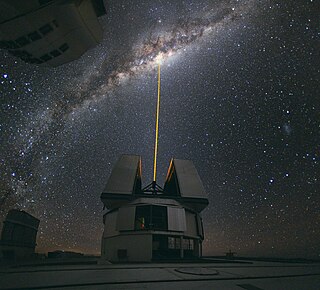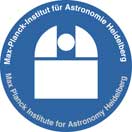
The following outline is provided as an overview and topical guide to space science:

The VLT Survey Telescope (VST) is a telescope located at ESO's Paranal Observatory in the Atacama Desert of northern Chile. It is housed in an enclosure immediately adjacent to the four Very Large Telescope (VLT) Unit Telescopes on the summit of Cerro Paranal. The VST is a wide-field survey telescope with a field of view twice as broad as the full Moon. It is the largest telescope in the world designed to exclusively survey the sky in visible light.

The European Space Astronomy Centre (ESAC) near Madrid in Spain is the ESA's centre for space science. It hosts the science operation centres for all ESA astronomy and planetary missions together with their scientific archives. Past and present missions represented at ESAC include Akari, BepiColombo, Cassini–Huygens, Cluster, Exomars, Gaia, Herschel Space Observatory, Hubble Space Telescope, ISO, INTEGRAL, IUE, James Webb Space Telescope, LISA Pathfinder, Mars Express, Planck, Rosetta, SOHO, Solar Orbiter, Venus Express, and XMM-Newton.

Teide Observatory, IAU code 954, is an astronomical observatory on Mount Teide at 2,390 metres (7,840 ft), located on Tenerife, Spain. It has been operated by the Instituto de Astrofísica de Canarias since its inauguration in 1964. It became one of the first major international observatories, attracting telescopes from different countries around the world because of the good astronomical seeing conditions. Later, the emphasis for optical telescopes shifted more towards Roque de los Muchachos Observatory on La Palma.

The Max-Planck-Institut für Astronomie is a research institute of the Max Planck Society (MPG). It is located in Heidelberg, Baden-Württemberg, Germany near the top of the Königstuhl, adjacent to the historic Landessternwarte Heidelberg-Königstuhl astronomical observatory. The institute primarily conducts basic research in the natural sciences in the field of astronomy.
Solar physics is the branch of astrophysics that specializes in the study of the Sun. It intersects with many disciplines of pure physics and astrophysics.

The Astronomical Observatory of Capodimonte is the Neapolitan department of Istituto Nazionale di Astrofisica, the most important Italian institution promoting, developing and conducting scientific research in the fields of astronomy, astrophysics, and space science.

Konkoly Observatory is an astronomical observatory located in Budapest, Hungary is part of the Research Centre for Astronomy and Earth Sciences and belongs to the HUN-REN Magyar Kutatási Hálózat. Konkoly Observatory was founded in 1871 by Hungarian astronomer Miklós Konkoly-Thege (1842–1916) as a private observatory, and was donated to the state in 1899. Konkoly Observatory, officially known as HUN-REN CSFK Konkoly Thege Miklós Csillagászati Intézet in Hungarian, is the largest astronomical research institute in Hungary, and hosts the largest telescopes in the country. The Observatory has more than 60 researchers, a quarter of them are non-Hungarian.

The Brera Observatory is an astronomical observatory in the Brera district of Milan, Italy. It was built in the historic Palazzo Brera in 1764 by the Jesuit astronomer Roger Boscovich. Following the suppression of the Jesuits by Clement XIV on 21 July 1773, the palace and the observatory passed to the then rulers of northern Italy, the Austrian Habsburg dynasty.

The Astronomical Observatory of Rome is one of twelve Astronomical Observatories in Italy. The main site of the Observatory is Monte Porzio Catone. Part of the Istituto Nazionale di Astrofisica since 2002.

The Medicina Radio Observatory is an astronomical observatory located 30 km from Bologna, Italy. It is operated by the Institute for Radio Astronomy of the National Institute for Astrophysics (INAF) of the government of Italy.

Catherine Jeanne Cesarsky is an Argentine and French astronomer, known for her research activities in astrophysics and for her leadership in astronomy and atomic energy. She is the current chairperson of the Square Kilometre Array's governing body, SKAO Council. She was the first female president of the International Astronomical Union (2006-2009) and the first female director general of the European Southern Observatory (1999-2007).

Leibniz Institute for Astrophysics Potsdam (AIP) is a German research institute. It is the successor of the Berlin Observatory founded in 1700 and of the Astrophysical Observatory Potsdam (AOP) founded in 1874. The latter was the world's first observatory to emphasize explicitly the research area of astrophysics. The AIP was founded in 1992, in a re-structuring following the German reunification.

The National Institute for Astrophysics is an Italian research institute in astronomy and astrophysics, founded in 1999. INAF funds and operates twenty separate research facilities, which in turn employ scientists, engineers and technical staff. The research they perform covers most areas of astronomy, ranging from planetary science to cosmology.

In 2011, Chile was home to 42% of the world's astronomical infrastructure, consisting principally of telescopes. In 2015, it was estimated that Chile would contain more than 50% of the global astronomical infrastructure by 2030. In the Atacama desert region of northern Chile, the skies are exceptionally clear and dry for more than 300 days of the year. These conditions have attracted the world's scientific community to develop highly ambitious astronomical projects in the Atacama desert.
Giampaolo Vettolani is an Italian astrophysicist, scientific director of the National Institute for Astrophysics in Rome (INAF) since 2012.
Science tourism is a travel topic grouping scientific attractions. It covers interests in visiting and exploring scientific landmarks, including museums, laboratories, observatories and universities. It also includes visits to see events of scientific interest, such as solar eclipses.

The Science Programme of the European Space Agency is a long-term programme of space science and space exploration missions. Managed by the agency's Directorate of Science, The programme funds the development, launch, and operation of missions led by European space agencies and institutions through generational campaigns. Horizon 2000, the programme's first campaign, facilitated the development of eight missions between 1985 and 1995 including four "cornerstone missions" – SOHO and Cluster II, XMM-Newton, Rosetta, and Herschel. Horizon 2000 Plus, the programme's second campaign, facilitated the development of Gaia, LISA Pathfinder, and BepiColombo between 1995 and 2005. The programme's current campaign since 2005, Cosmic Vision, has so far funded the development of ten missions including three flagship missions, JUICE, Athena, and LISA. The programme's upcoming fourth campaign, Voyage 2050, is currently being drafted. Collaboration with agencies and institutions outside of Europe occasionally occur in the Science Programme, including a collaboration with NASA on Cassini–Huygens and the CNSA on SMILE.

Luigi Rolly Bedin, is an Italian astrophysicist and researcher at the National Institute of Astrophysics of the Padua Astronomical Observatory. His research focuses on stellar populations in open and globular clusters, exoplanets and nearby brown dwarfs. He is the discoverer with his team of the dwarf spheroidal galaxy Bedin I. He is a member of the International Astronomical Union.


















